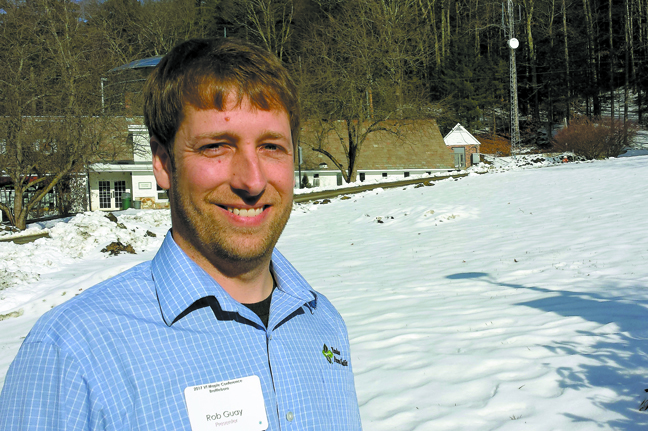Sugarbush Management
Expert provides tips on sugarbush appraisal
'You really need to know what you’re buying,' appraiser says
By PAUL POST | MARCH 2017
BRATTLEBORO, VT. — Understanding the ins and outs of property appraisals can maple producers make well-informed, wise decisions before purchasing sugarbush.
Whether the site has an existing operation or its virgin woodland, Bob Guay of Yankee Farm Credit, explained the many things involved with an appraisal and the help that’s available, during the Jan. 21. Winter Maple Conference in Brattleboro, Vt.
Guay is the Williston, Vt.-based company’s manager of appraisal services and also runs a 6,500-tap maple operation with his family in West Chazy, N.Y.
“You really need to know what you’re buying,” he said. “Handshake deals can fall apart with the next owner and courts can rule against you.”
For example, a current neighbor that grants right-of-way to reach the sugarbush might be replaced by someone who isn’t so friendly. Or a land owner who doesn’t mind tubing or electric lines crossing their property might be followed by someone who does.
“You need to know these things,” Guay said.
Several different types of value may be applied to any piece of property such as its tax, business, insurance, sentimental and market values. An assessment, based on a government formula, is used to determine a propertys tax value.
In contrast, an appraisal is an expert estimate of its market value.
Market value is the most probable price that a property should bring in a competitive and open market, where the buyer and seller are both acting in their best interests, Guay said. They’re well-informed and well-advised.”
“We talk with buyers and sellers, which is the best way to determine what people are looking for,” he said. “What turns you on and off about pieces of property?”
When selling sugarbush, it’s important to list it with the right realtor, Guay said.
“What we’re looking for is exposure to the proper buyer pool,” he said. ” You need to get the right people to look at the property.” Typically, property is appraised at its highest and best use. For sugarhouses, maple is the highest and best use.
Anyone looking to buy land should do a thorough and complete review of the property first. This includes a physical inspection by walking, riding through and/or flying over the site to determine its topography, which is important to the maple operation’s layout and design.
But many other resources are available, too, including deeds, and municipal assessment, tax and soil maps and records. These should be checked against each other for potential discrepancies.
“This is really detective work,” Guay said.” You really need to be careful on these kinds of things.”
There are three main approaches to determining value. They are:
-- Sales comparison. What have similar properties sold for?
“We base everything on market data and an analysis of real estate sales,” Guay said.
-- Cost.
This only applies to properties with buildings. What does it cost to build a sugarhouse? What does it cost to put in a pipeline? This could vary greatly depending on the sites topography and ease of access. A steep slope, bowl or deep gullies could be limiting factors and raise the price of installing systems.
-- Income potential.
“The present value is indicated by the expectation of future benefits,” Guay said. “The greater the income potential, the more value the property has.”
For maple producers, several main considerations should be kept in mind when buying sugarbush that may not apply to other woodland owners. These includes the sites access, electric service, density of trees and ease of operations.
With regard to access, how much road frontage is there? Frontage might be extensive, but it may not have much value if this part of the property is steep or swampy. Also, where are the propertys high and low points? This will affect location of the sugarhouse. Does the town plow roads in winter or the property owner himself?
“Dont assume because theres a road that its a right-of-way,” Guay said. ”You can’t assume just because theres a road that you have the right to use that road if you buy the property. If you have any doubt about what your rights are, get legal advice. It can save you thousands of dollars.”
Electric service is vital to modern maple production because of the expanded use of reverse osmosis and vacuum-pump systems. Before buying land, find out what service is available, the cost involved with extending power lines, and whether this is even possible.
Generators are common, but they're less efficient than public electric service, Guay said.
Tree density is probably the biggest driver of sugarbush value as it determines the total potential taps per acre, Guay said.
With 5/16-inch spouts, the guideline is one tap per tree thats 10-14 inches in diameter; two taps for 16-20 inch trees; and three taps for trees 22 inches or larger, he said.
”Management differences can really impact tap counts,” Guay said.
When it comes to ease of operation, a 600-acre parcel that slopes to one spot would be ideal. Again, slope steepness and direction are important considerations. Also, what type of access is there to the back of property? This could be quite difficult if theres a lot of underbrush.
Other amenities go into determining property value, too, such as wells, water supply, wastewater disposal and non-maple timber that might produce revenue.
If the site has an existing maple operation, equipment should be checked to determine its remaining utility. A review of production history might indicate its usefulness.
“It’s really hard to manage a bad system to good production,” Guay said.
For the most part, sugarbush values have been fairly stable since 2012. Of course, every site is different and current economic conditions may affect price, too.































